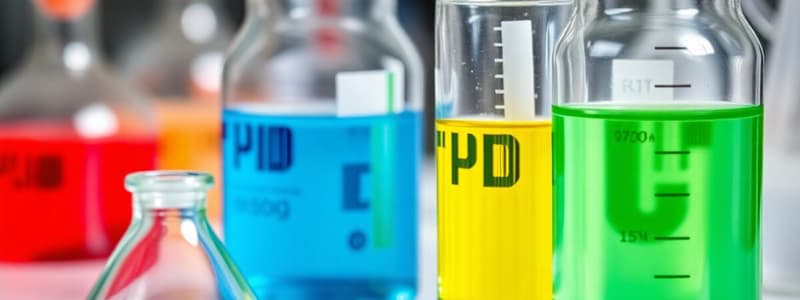Podcast
Questions and Answers
What does the physical appearance of a chemical substance help identify?
What does the physical appearance of a chemical substance help identify?
- The thermal stability of the compound
- The exact molecular formula of the compound
- The solubility of the substance in water
- The presence of certain cations (correct)
What is the primary purpose of the borax bead test?
What is the primary purpose of the borax bead test?
- To color the flame for aesthetic purposes
- To determine the pH of the sample
- To identify specific metal ions present in colored salts (correct)
- To induce a chemical reaction with air
In the charcoal cavity test, what happens to metallic carbonates upon heating?
In the charcoal cavity test, what happens to metallic carbonates upon heating?
- They decompose into respective oxides (correct)
- They produce a gas that ignites spontaneously
- They melt into a liquid state
- They dissolve completely in water
Which of the following is a key step in conducting a dry test for identifying metal ions?
Which of the following is a key step in conducting a dry test for identifying metal ions?
What color represents ionic compounds formed from representative elements in general?
What color represents ionic compounds formed from representative elements in general?
What is the primary purpose of conducting a flame test on a salt sample?
What is the primary purpose of conducting a flame test on a salt sample?
Which of the following statements about solubility is correct?
Which of the following statements about solubility is correct?
What happens to chlorides when they are heated in a flame during a flame test?
What happens to chlorides when they are heated in a flame during a flame test?
Which of the following correctly defines approximate quantities in analytical chemistry?
Which of the following correctly defines approximate quantities in analytical chemistry?
What is the significance of dipping the platinum wire in concentrated HCl before performing the flame test?
What is the significance of dipping the platinum wire in concentrated HCl before performing the flame test?
Flashcards
Dry Test (Qualitative Analysis)
Dry Test (Qualitative Analysis)
A simple test where a solid unknown substance is heated with a reagent in a dry state to observe reactions and changes.
Physical Appearance Test (Qualitative Analysis)
Physical Appearance Test (Qualitative Analysis)
This test involves carefully observing the physical characteristics of a substance like color, smell, and crystal shape to predict the presence of certain cations.
Heating Test (Qualitative Analysis)
Heating Test (Qualitative Analysis)
A test where a sample is heated in a dry ignition tube and the color of the flame is observed to identify the presence of certain metal ions, especially alkali and alkaline earth metals.
Charcoal Cavity Test (Qualitative Analysis)
Charcoal Cavity Test (Qualitative Analysis)
Signup and view all the flashcards
Borax Bead Test (Qualitative Analysis)
Borax Bead Test (Qualitative Analysis)
Signup and view all the flashcards
Flame Test
Flame Test
Signup and view all the flashcards
Volatile Compounds
Volatile Compounds
Signup and view all the flashcards
Chlorides
Chlorides
Signup and view all the flashcards
Approximate Quantity
Approximate Quantity
Signup and view all the flashcards
Exact Quantities
Exact Quantities
Signup and view all the flashcards
Study Notes
Qualitative Analysis Methods
-
Dry Tests: Involve solid reagents and samples, often heated.
-
Physical Appearance (Visual): Initial observation of color, odor, and crystalline shape can help identify some ions. Ionic compounds from representative elements are usually colorless/white. Transition metal ions are typically colored. Smell can also indicate specific ions (e.g., ammonium).
-
Heating Test: Heating a sample (5 mg) in a dry ignition tube reveals changes in color and appearance. Changes help in identifying alkali and alkaline earth metals.
-
Charcoal Cavity Test: Heating metal carbonates in a charcoal cavity leads to oxide formation. The resulting oxide's color and form (incrustation, metallic bead) can aid identification.
-
Borax Bead Test: Borax (Na2B4O7.10H2O) reacts with metal salts to form colored metal borates. A platinum wire loop containing borax powder is heated, then dipped into the salt and again heated. The metal is indicated by the flame color (hot and cool, luminous and non-luminous).
-
Flame Test: Volatilization of metal compounds (especially chlorides) produce characteristic colors in a flame. A platinum wire treated with concentrated HCl is dipped into a solution and held in the flame. The flame color identifies specific ions.
Solubility Rules
- Soluble: All nitrates; sodium, potassium, and ammonium salts.
- Mostly Soluble: Most chlorides, bromides, and iodides. Exceptions include silver, mercury (I), and lead (II).
- Mostly Soluble: Most sulfates. Exceptions include strontium, barium, and lead (II); calcium and silver (moderately soluble).
- Insoluble: All carbonates, sulfites, and phosphates. Exceptions include sodium, potassium, and ammonium salts.
Numerical Quantities in Analysis
- Exact Quantities: These are constant or derived from counting (e.g., element valences). They also involve relationships between units (1 kg = 1000 g).
- Approximate Quantities: All measurements such as weighing are approximate. The last decimal place is unreliable since weighing has limited precision.
Studying That Suits You
Use AI to generate personalized quizzes and flashcards to suit your learning preferences.




